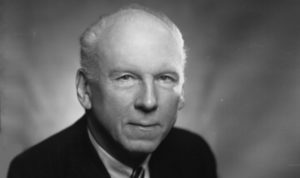In June 2019, an electric guitar known as “The Black Strat”—played for decades by Pink Floyd’s David Gilmour—was auctioned for a little less than $4 million, making it the most expensive guitar ever sold.1 Emblazoned on its headstock is the name “Fender,” after its late designer, Leo Fender, who never learned to play or even tune a guitar but who undoubtedly changed the course of music history.
Leo was an unlikely character to revolutionize music. He was a quiet kid, even more so after losing an eye in a childhood accident. But the gears of his mind turned at the sight of any unfamiliar contraption, including, at age ten, the first car he’d ever seen—which he promptly crawled under for a view of its mechanics. By the time he was in high school, he was repairing radios and had built an antenna atop his parents’ barn, where he had been born a little more than a decade earlier on August 10, 1909.
His glass eye kept him out of the military during WWII, by which time he had opened Fender Radio and Record Shop.2 He would often note design flaws in the instruments and amplifiers musicians brought in for repair. Instead of merely fixing them, he made them more reliable and better sounding than they’d ever been—and musicians took note. By the mid-forties, several public address systems (PAs) he had built were being rented out almost continuously, and he’d sold a few as well. He began building amplifiers, and by the late 1940s, the most popular band west of the Mississippi, Bob Wills and his Texas Playboys, would use none other.3 . . .
You might also like
Endnotes
1. Julia Gray, “David Gilmour’s Black Strat Breaks the Record for Most Expensive Guitar Sold at Auction,” Stereogum, June 20, 2019, https://www.stereogum.com/2048591/david-gilmour-black-strat-break-record-most-expensive-guitar-auction/news/.
2. He opened the shop in 1938.
3. Ian Port, The Birth of Loud: Leo Fender, Les Paul, and the Guitar-Pioneering Rivalry That Shaped Rock ’n’ Roll (New York: Scribner, 2019), loc. 323; Port’s book is an excellent history of the creation and evolution of the electric guitar and bass, and of the musicians who used them.
4. “The Log Heard ’Round the World,” Epiphone, March 14, 2018, http://www.epiphone.com/News/Features/2017/The-Log-Heard-Round-the-World.aspx.
5. Gibson did release a solid-body electric guitar, the Gibson Les Paul, in 1952, in response to the success of Fender’s solid-body electric guitar, which was released in 1950 and is discussed below.
6. Jim Washburn, “Leo Fender: His Contribution Struck a Chord Around World,” Los Angeles Times, March 23, 1991, https://www.latimes.com/archives/la-xpm-1991-03-23-ca-653-story.html.
7. After receiving a cease and desist letter from lawyers at the instrument company Gretsch, someone at the Fender factory cut “Broadcaster” off the Fender headstock decals, leaving only “Fender.” These guitars, which shipped for a brief period in 1951, came to be called “Nocasters,” because they lacked a model name, but they are essentially Telecasters.
8. The Bassman has undergone numerous iterations, most of which also have become favorites among guitar players.
9. In 1985, president of CBS’s Fender division William Schultz convinced CBS to sell the company to a management group he led. The new company, Fender Musical Instruments Corporation, quickly changed course, and by the mid-1990s, was producing quality instruments and had grown exponentially in value. See “Fender Musical Instruments Company History,” Funding Universe, http://www.fundinguniverse.com/company-histories/fender-musical-instruments-company-history/ (accessed August 5, 2019).
10. Jon Wiederhorn, “Dragon Slayer: The Magical Mystery of Jimmy Page’s Painted Telecaster,” Fender, https://www.fender.com/articles/gear/chasing-the-dragon-the-magical-mystery-of-jimmy-page-s-painted-telecaster (accessed August 3, 2019).
11. Port, Birth of Loud, loc. 3425.
12. Damian Fanelli, “Mark Knopfler Discusses His ’61 Strat and ‘Sultans of Swing,’” Guitar World, August 12, 2016, https://www.guitarworld.com/artists/mark-knopfler-discusses-his-61-strat-and-sultans-swing.
13. “Sultans of Swing,” Wikipedia, https://en.wikipedia.org/wiki/Sultans_of_Swing#Charts (accessed August 3, 2019).
14. Port, Birth of Loud, loc. 3906.
15. Washburn, “Leo Fender: His Contribution Struck a Chord Around World.”
16. These players are pictured and/or listed in Music Man’s 1977 and/or 1980 amp catalogs. See “Music Man Amps: Catalog Sheets,” http://pacair.com/mmamps/Manuals/Catalogs/catalogs.html (accessed August 5, 2019).
17. George Fullerton, Guitars from George and Leo (Milwaukee, WI: Hal Leonard, 2005), loc. 38.
18. Washburn, “Leo Fender: His Contribution Struck a Chord Around World.”
















